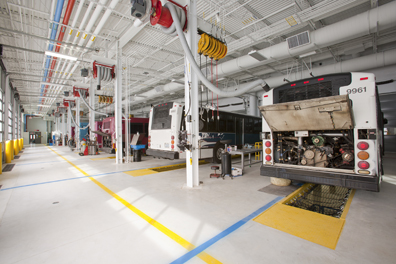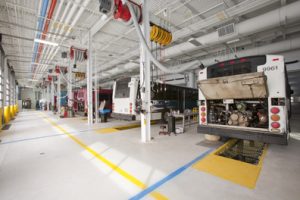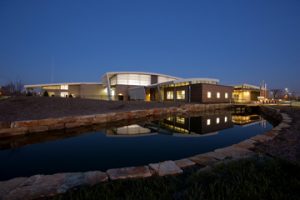
By Merlin Maley

In 2007, TRANSPO (South Bend Public Transportation Corporation of Indiana (TRANSPO) turned to RNL, Maintenance Design Group, and Forum Architects, Denver, CO, to design and build its new Emil “Lucky” Reznik Administration, Maintenance and Operations Facility, a structure that would prove functional, layered and sustainable. The Emil “Lucky” Reznik Administration, Maintenance & Operations Facility opened in November 2010.
Transpo wanted its new facility to exemplify the interaction between program, function and iconic design, while highlighting the transportation services it provides. The Reznik facility is on track to earn credentials as the first building in Indiana, as well as the first bus administration, operations and maintenance building in the United States to achieve LEED Platinum certification from the U.S. Green Building Council.
“We wanted to be leaders, not followers,” says TRANSPO Board Chairman John Leszczynski. “But we wanted to do it in such a way we did not forsake the rich history of this site.”
Originally developed as a Studebaker manufacturing facility in the late 19th century, when factory production eased in the early 1960s and finally halted in the late 1990s, the city of South Bend remediated the brownfield site to prepare for construction, which included the demolition and recycling of unusable factory buildings.
“Our northside facility started out as a milking shed in the 1890s and has been adapted many times over the century to address our needs as a transit agency,” says TRANSPO General Manager, Maurice Pearl. “To meet the needs of our riders in the 21st Century, we needed to build a new state of the art facility that conserves energy and operating revenue so that we could spend our money providing improved and increased transit services to the South Bend and Mishawaka communities.”

As the first development in the new Ignition Park light-industrial land use complex, this unique project responds to both the desire to create a highly sustainable project and the goal of producing architecture that embraces site, civic identity and function.
According to the agency the facility contains all operations within one building in order to reduce, reuse and recycle. The construction materials included recycled, reused content selected for durability and sustainable functionality 50 years and beyond — similar to the Studebaker, which is now a collectible vehicle prized for its high level design and quality.
Architecture is seamless
Expansive, daylit spaces provide for transparency and diminish the boundaries between interior and exterior spaces. The shared lobby and boardroom invites the community into the TRANSPO home for public events, which engages the public in an educational dialog regarding sustainable development and public transportation.
The landscape as an ecosystem
Treated as an ecosystem, the landscape creates layers of space that function as buffers, outdoor break areas, detention areas and pathways for storm water movement.
Harvested roof drainage and surface runoff from parking lots create the staples of the landscape design and re-establish wetlands and native habitat to the region while using plants to biologically remediate and retain 100 percent of the site’s storm water on site.
TRANSPO says 83.70 percent of the total wood material costs come from sustainable harvest certified forests, where LEED exemplary performance is 95 percent.
Form and function are one
Operators have their own entry to a private area with lockers, quiet area, TV alcove, kitchenette, showers and exercise room, creating a comfortable and efficient rest area during shift changes and breaks in daily schedules. The administrative spaces include private offices that wrap an open office area with expansive views to the exterior. Functional spaces such fueling, fare retrieval, and wash capabilities connect in a safe left-hand–turn-only circulation model.
“Our new maintenance operations improve our performance and vehicle turn around time in a safe, comfortable, and efficient working environment,” says Maintenance Manager Mike Stahly. “We have eight maintenance bays that connect the bus storage area designed for internal bus circulation, which allows the facility to operate at maximum efficiency regardless of inclement weather.”
The facility provides expansive daylit spaces, promotes transparency and works to diminish the boundaries between the interior and exterior. By embracing daylighting the design reduces the need to expend energy to provide artificial lighting during the day. Electric lighting automatically controlled through sensors and dimmable fixtures complements the daylighting.
A ground source pump system provides heating and cooling to all regularly occupied administration, operations, and maintenance office areas. The system is extremely energy efficient because it uses the ambient temperature of the Earth, which in this area is approximately 55 dF, to either provide pre-heating or pre-cooling depending on the season.
A digital display inside the lobby provides up-to-date information about the amount of energy the building is creating from its 92 kW photovoltaic roof panels. The system also tracks the amount of potable water saved from water-reducing lavatory fixtures and the facility’s recycled-water bus wash system, as well as the amount of storm water that has been detained on site.
While, the new building is almost twice as large as the old facility, TRANSPO says in January and February 2011 the total utility costs were approximately 94 percent of what they were in 2010 at the Northside Facility. BR
Merlin Maley, AIA, LEED AP, serves as an associate with RNL, Denver, CO, a global, full-service firm specializing in sustainable, integrated design. Maley has over 12 years of experience and is an integral member of the RNL transportation team.
